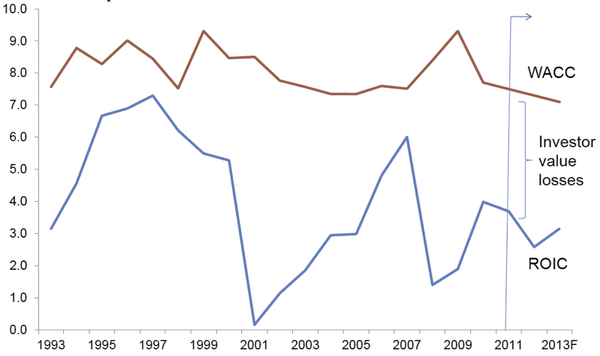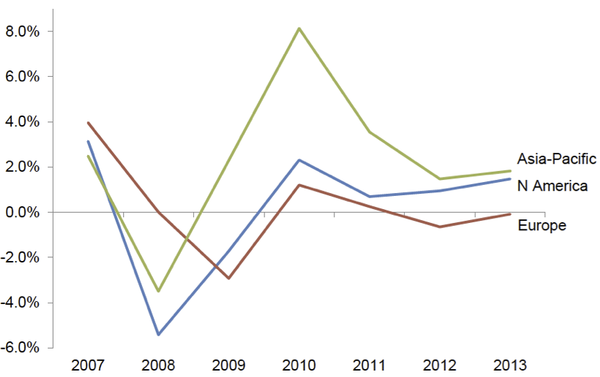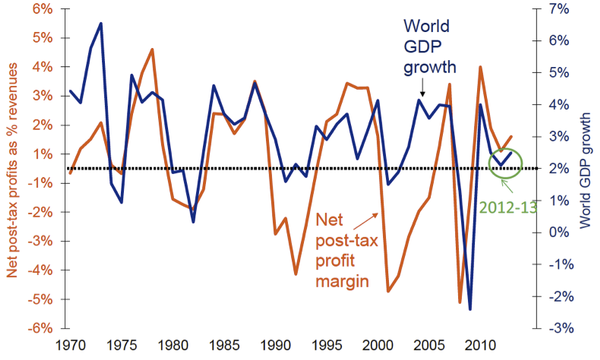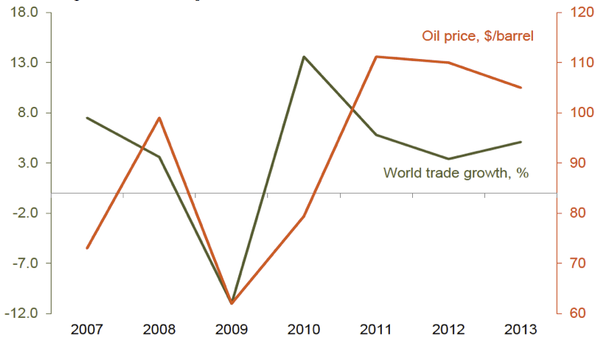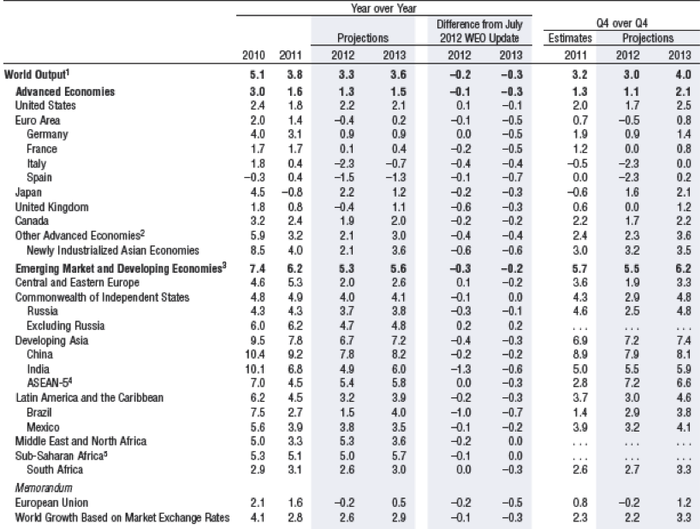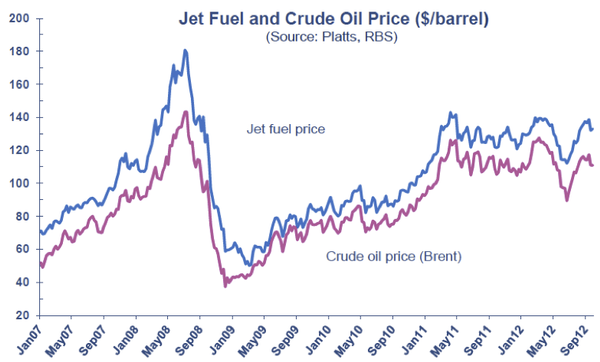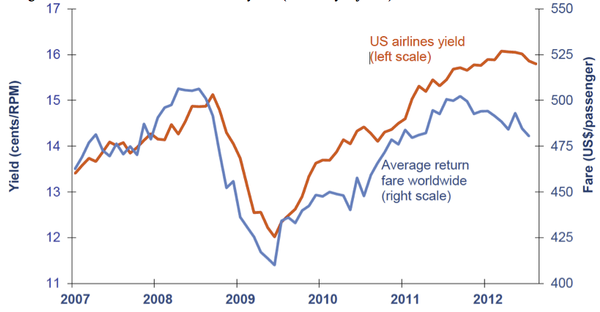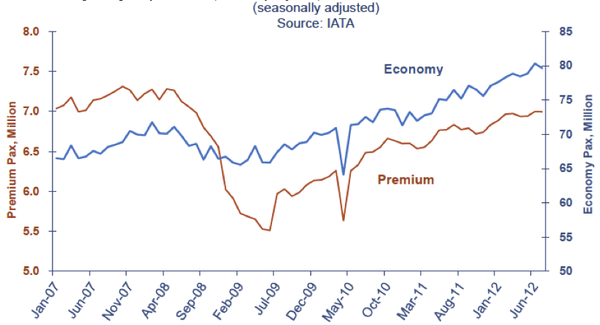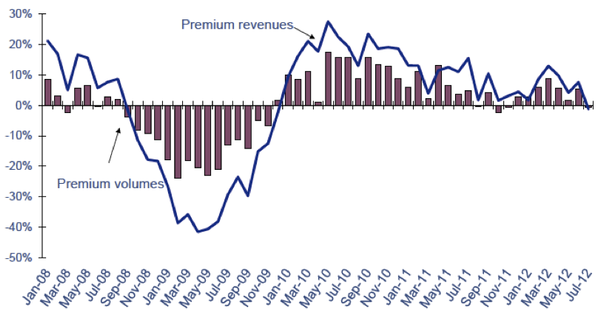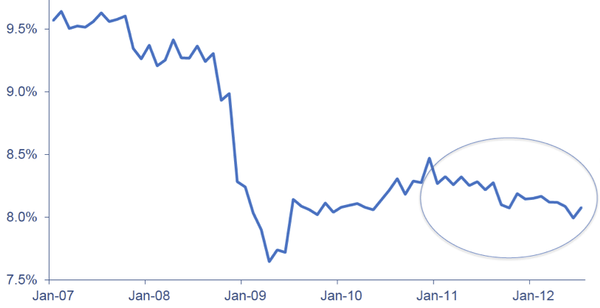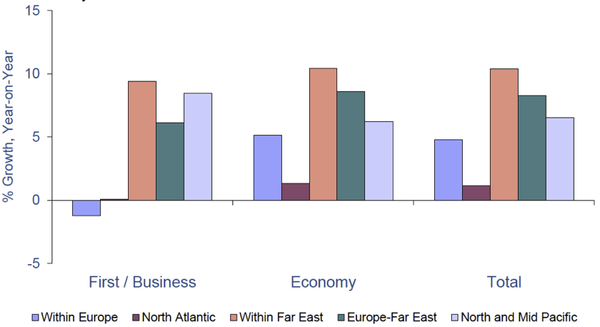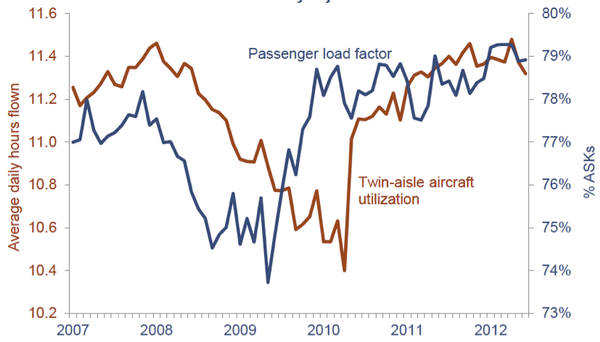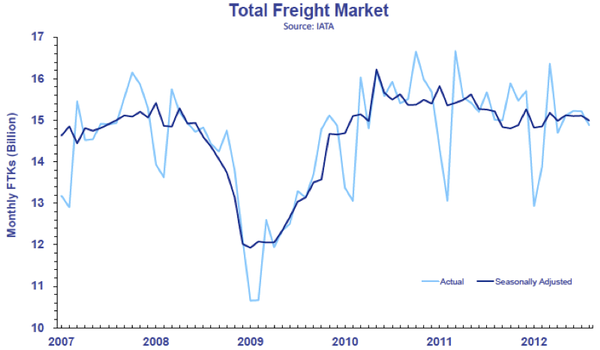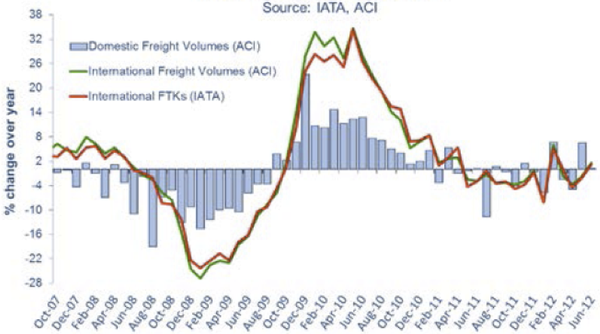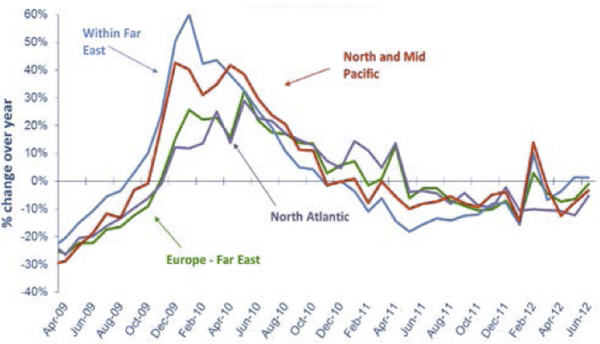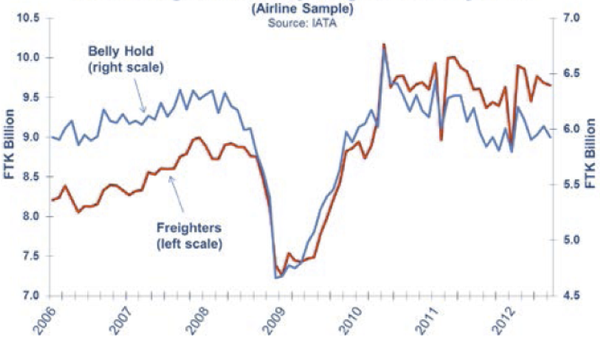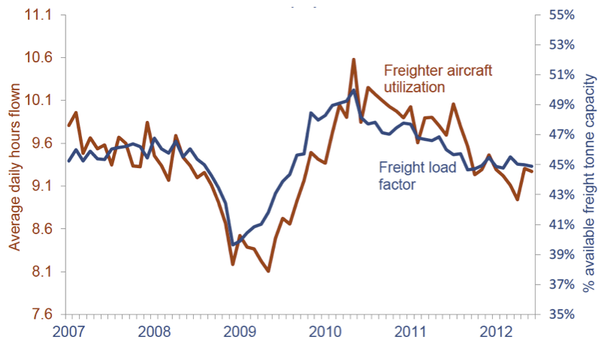Airline profitability prospects improve but profit margins remain anaemic
Airline profitability prospects have improved for 2012, with IATA upwardly revising its 2012 financial forecast on 01-Oct-2012, predicting a USD4.1 billion profit compared to USD3 billion forecast in Jun-2012.
However, IATA director general and CEO Tony Tyler cautioned that "we should not get too excited" about the revision, with profits still to be less than half the USD8.4 billion earned in 2011 and considerably lower than the USD19.2 billion achieved in 2010. A return to those levels is not anticipated any time in the near future.
Despite the upward revision, profit margins also remain anaemic, with Mr Tyler noting that the revision only increased net profit margins from 0.5% to a still "miniscule" 0.6%.
Airline industry profitability is expected to pick up modestly to USD7.5 billion in 2013, amid slightly faster growth, lower oil prices combined and an upwardly revised GDP forecast.
But in general, airlines are continuing their 'cautious capacity growth' mantra to the benefit of load factors, yields and profitability.
However, as Mr Tyler notes, this level of profitability still equates to a net margin of just 1.1%, indicating the relative unattractiveness of investment in this sector.
IATA noted that with the forecast profitability, "airlines will be able to pay their bills and service their debt, but there is very little left over for the shareholder". IATA estimates return on capital will be 3% on average in 2013, "but investors would expect to earn a return of 7-8% in an industry with a similar risk profile to airlines". IATA continued, "The fact that the airline industry persistently earns less than its cost of capital is a measure of the intensely competitive environment. Consolidation in the US and Europe, including JVs on many long-haul markets, is starting to make a difference. There is still a long way to go before 'normal' profits are earned".
Return on invested capital in airlines and their WACC: 1993 to 2013 (forecast)
Airlines' regional differences remain, with AsiaPac strongest. Europe's industry forecast is revised downward
North American airlines show the greatest improvement in prospects since the Jun-2012 forecast, anticipated to report a USD1.9 billion profit, USD500 million more than forecast in Jun-2012. "This has been driven largely by a trimming of capacity which has given them the highest load factors and improved yields. Notably, North America and Latin America are the only two regions that are expected to see profits rise in 2012 over 2011 levels," Mr Tyler said.
Latin America continues to show robust growth in traffic, reflecting demand generated by strong trade flows from the region, but also robust growth in economies such as Mexico and Chile. Capacity cuts have stemmed airline losses on Brazil's domestic market, bringing supply and demand into better balance. On international markets consolidation is also becoming evident in transactions such as the LATAM merger.
Meanwhile, Asia Pacific airlines are expected to be the best performers, contributing USD2.3 billion profit, up USD300 million from the previous forecast. However, with 40% of the global cargo market, the region's carriers are the most exposed to weak cargo demand, which has declined by 7% in the first eight months of 2012. However, soft cargo markets have been more than offset by relatively robust performance in passenger markets. China, for example continues to have the fastest growing major domestic market.
Middle East airlines have seen a major improvement in their prospects, from USD400 million to USD700 million, as the region's carriers continue to successfully expand their long-haul market share with connections through their expanding hubs.
African airlines, meanwhile, are seeing an improvement from a USD100 million loss forecast in Jun-2012 to a break-even result, reflecting the strong growth of many African economies, boosted in some cases by investment and trade links with China and for some by strong oil revenues, although its profitability has been impacted by weak load factors, on average the lowest in the world as many of the region's airlines struggle to match capacity with demand.
IATA airline net post-tax profit margins: 2007 to 2013 (forecast)
The situation for European airlines has however worsened and their performance has deteriorated substantially, reflecting weak home markets due to the eurozone crisis, with the region also suffering under high taxes, inefficient air traffic management infrastructure and regulatory restrictions. In Jun-2012, IATA was forecasting a USD1.1 billion loss, now revised to a USD1.2 billion loss. "Not only is the economy weak with the Eurozone crisis, Europe has some very unfriendly conditions for doing business - onerous regulations, high taxes, insufficient capacity at many key airports and an air traffic management system badly in need of modernisation," Mr Tyler said. The forecast for Latin America remains unchanged.
2012 forecast progression (based on central forecast): Net profits (USD, billions) and EBIT margin (%)
|
Sep-2011 |
Dec-2011 |
Mar-2012 |
Jun-2012 |
Sep-2012 |
|
|---|---|---|---|---|---|
|
Global |
USD4.9b |
USD3.5b |
USD3.0b |
USD3.0b |
USD4.1b |
|
2.0% |
1.4% |
1.3% |
1.4% |
1.6% |
|
|
USD1.2b |
USD1.7b |
USD0.9b |
USD1.4b |
USD1.9b |
|
|
2.4% |
2.4% |
2.0% |
2.2% |
3.0% |
|
|
USD0.3b |
(USD0.6b) |
(USD0.6b) |
(USD1.1) |
(USD1.2b) |
|
|
0.8% |
0.3% |
0.3% |
0.0% |
-0.1% |
|
|
USD2.3b |
USD2.1b |
USD2.3b |
USD2.0b |
USD2.3b |
|
|
2.8% |
2.1% |
2.0% |
2.2% |
1.9% |
|
|
USD0.7b |
USD0.3b |
USD0.5b |
USD0.4b |
USD0.7b |
|
|
2.9% |
1.6% |
1.9% |
1.7% |
2.5% |
|
|
USD0.5b |
USD0.1b |
USD0.1b |
USD0.4b |
USD0.4b |
|
|
3.1% |
1.8% |
1.8% |
2.8% |
2.7% |
|
|
(USD0.1b) |
(USD0.1b) |
(USD0.1b) |
(USD0.1b) |
USD0b |
|
|
0.2% |
0.3% |
-0.3% |
0.0% |
0.7% |
Regional divergences are expected to persist in 2013. North American airlines should continue to improve profitability based on tight capacity management. Asia Pacific carriers will see a profitability boost from improved cargo volumes (if not yields). European airlines are expected to be the only region in the red for 2013, although losses will be trimmed as a result of slower capacity growth and improved global trading conditions on long-haul markets.
Global economic weakness remains a concern. Airlines typically lose money when growth falls below 2%
Current global GDP and business conditions remain weak, with global GDP growth at 2.1%.
Mr Tyler cautioned, "That is dangerously close to the 2.0% mark below which historically airlines have returned a collective loss. Today is good news … it means that airlines are keeping their heads above water better than we thought…in a very difficult operating environment". Economic growth and world trade growth are expected, by most forecasters, to increase at a slightly faster pace in 2013 than in 2012, and many of the serious economic risks related to substantial deterioration of the eurozone crisis were alleviated this year. However, despite easing risks, the situation remains fragile.
World economic growth and airline profit margins: 1970 to 2010
World trade growth and Brent oil prices: 2007 to 2013 (forecast)
The IMF, in its Oct-2012 World Economic Outlook, noted that the global economic recovery is continuing but has weakened and that the economic recovery has "suffered new setbacks, and uncertainty weighs heavily on the outlook". IMF said the downside risks are now judged to be more elevated than in its previous Sep-2011 and Apr-2012 forecasts. Relative to its Apr-2012 forecasts, the Oct-2012 forecasts for 2013 growth have been revised from 2.0% to 1.5% for advanced economies, and from 6.0% to 5.6% for emerging market and developing economies. IMF economic counsellor Olivier Blanchard noted that those forces pulling growth down in advanced economies are fiscal consolidation and a still-weak financial system that the IMF noted "is still not functioning efficiently". IMF also noted that the outlook for 2013 globally is highly dependent on "on whether European and U.S. policymakers deal proactively with their major short-term economic challenges". Mr Blanchard added, "low growth and uncertainty in advanced economies are affecting emerging market and developing economies".
Although economic growth in the euro area is likely to contract overall in 2012, the US is expected to improve on 2011 performance, as is Japan. Growth in emerging markets continues to significantly outpace western economies, with robust expansion anticipated throughout Asia Pacific, MENA, sub-Saharan Africa and Latin America in 2012. Western economies continue to be limited by tightening fiscal policy, while the governments of Brazil, Russia, India and China maintain a relatively looser fiscal position.
IMF Overview of the World Economic Outlook Projections
Fuel costs remain persistently high but some relief in oil prices is expected in 2013
The outlook for the industry is also heavily linked to oil prices, although signs show that some relief will be seen on this front, with oil prices expected to decline in 2013. In 2013, fuel prices are expected to decline to USD105/barrel (Brent) which will hold the industry's fuel bill to USD208 billion (the same as is expected for 2012) even when factoring-in industry growth.
Since airline industry profitability peaked in 2010, oil prices has risen from USD79 to a historically-high USD110 on average in 2012, or USD127.7 a barrel for jet fuel. That 40% rise alone added around USD50 billion to unhedged fuel costs. The global airline industry's fuel bill is forecast to total over USD200 billion in 2012 (accounting for a third of operating expenses), almost five times 2003's fuel bill. As a result, fuel surcharges have become commonplace, less transparent and more expensive in the past few years.
Jet Fuel and Crude Oil Price (USD/barrel): Jan-2007 to Sep-2012
Rises in yields show signs of stalling
Despite increases in the cost of travel related to increased fuel and ancillary charges and eco and passenger taxes in some countries, average worldwide fares have declined in 2012 and are yet to return to pre-crisis levels. In contrast, US airline yields have increased strongly since the lows of mid-2009, although their strong rise is showing signs of stalling. Globally, passenger yield is expected to remain stable in 2013, following growth of 2% in 2012, while cargo yield is expected to decline 1.5% in 2013 following estimated yield declines of 2% in 2012.
Average return fare worldwide and US airlines yields (seasonally adjusted): 2007 to 2012
At the same time, premium passenger levels have yet to return to pre-crisis levels and after a steady increase in the second half of 2011, growth has stalled in 2012.
International air passengers by seat class (seasonally adjusted): Jan-2007 to Jul-2012
Premium ticket volume and revenue growth: Jan-2008 to Jul-2012
This reflects a deterioration in the seat mix, with the number of premium passengers as a percentage of the total declining from a recent peak at the end of 2011.
Premium passengers as a % of total (seasonally adjusted): Jan-2007 to Jan-2012
The decline in business confidence and the slowdown of world trade have reduced premium class travel in recent months and indicators signal continued and intensified declines in the coming months.
Premium passengers and world trade growth (left) and premium travel and business confidence (right): Jan-2007 to Jun-2012
The trend seen over the last few years highlights persisting weakness in premium travel within Europe and across the North Atlantic. Air travel markets elsewhere expanded overall, particularly within the Far East, although the weight of the economic problems in Europe is starting to dampen demand in other regions, with US and Chinese consumer confidence weakening in recent months.
Traffic Growth by Route: Jul-2011 to Jul-2012
Air travel growth is stalling and airlines respond to weakening demand by slowing capacity expansion
Global air traffic has slowed in recent months, expanding by only 1.2% since Jan-2012, reflecting falling business confidence and slowing world trade growth. Further declines in business confidence, now at a 38-month low, as well as the slowdown in world trade suggest that growth in air travel (and freight) will likely weaken further over the next few months. Traffic volumes are expected to grow slightly faster in 2013, driven by growth of cargo after its decline in 2012. Overall, airlines expect to carry some 3 billion passengers in 2013, with this number forecast to double by 2030.
In international markets, Asia Pacific traffic is expected to increase below the global average, at 3.5% in the region in 2012, compared to the forecast global growth of 3.7% on capacity growth of 3.3%. While European airlines have been facing recessionary conditions in a number of markets, traffic is expected to be only just below the global average in 2012, at 3.5%.
North American airlines, with their cautious capacity growth strategies, are forecast to increase traffic by only 0.5% in 2012, while the fastest growing region remains the Middle East. It will be the only region to see double-digit growth in 2012, at 14.8%.
Domestic traffic growth in China and Brazil remains strong, with traffic growth of 9.4% in both markets in the eight month to Aug-2012. Conversely, India's slowing economy and challenges among some of the nation's key carriers. In 2013, IATA is forecasting passenger traffic expansion of 4.5% and cargo expansion of 2.4%.
Worldwide air travel and air freight volume (seasonally adjusted): 2007 to 2012
Capacity, now well above pre-recession levels, is expected to be cautiously managed for the remainder of 2012 and in 2013, sustaining load factors, with capacity growth plans by airlines indicating reduced capacity expansion for later in 2012. North American airlines are expected to lead this cautious capacity trend, a key factor behind expectations of further improvements in profitability in this region.
Airlines in the Asia Pacific are expected to see renewed strong growth in 2013 as cargo recovers while Middle Eastern airlines are expected to continue to expand rapidly.
Total passenger and freight capacity (Seasonally adjusted): 2007 to 2012
Load factors decline from record highs, utilisation high in passenger business
Load factors in passenger markets have started to decline over recent months, as slowing capacity growth fails to offset demand declines. However, asset utilisation and load factors remain at historically high and record levels, allowing for yield improvements and a wider spread of fixed costs, providing evidence that consolidation is producing positive results. However, breakeven load factors have increased since fuel prices have risen sharply while yields have not improved noticeably.
Passenger load factor and aircraft utilisation (seasonally adjusted): 2007 to 2012
Passenger load factors are expected to increase in 2012 on a global level to 79.2% from 78.3% in 2011, with slight growth estimated for 2013 to 79.3%. Freight load factors are forecast to remain unchanged between 2012 and 2013 at 65.1%, compared to 64.9% in 2011, although break-even weight load factor is forecast to decline, from 64.1% in 2012 to 63.4% in 2012. This compares to a break-even weight load factor of 63.0% in 2011.
Cargo business remains weak
The signs of a minor recovery that were evident in air freight markets early in 2012 are fading, reflecting waning consumer confidence in major economies, weakening demand for air freighted consumer goods.
Reflecting reduced demand levels, freight capacity is also being reduced, both through the retiring of aircraft and a reduction in aircraft utilisation rates.
Total freight markets (monthly RPKs): 2007 to 2012
Freight traffic growth: Oct-2007 to Jun-2012
International freight growth by major routes: Apr-2009 to Jun-2012
Air freight carried by freighter or bellyhold: 2006 to 2012 (airline sample)
Cargo profitability has come under downward pressure in 3Q2012, with initial signs of improved demand stalling. IATA, in its Cargo e-Chartbook for 3Q2012, noted that the growth momentum in trade volumes is slowing, and business confidence has reversed the upward trend seen earlier in 2012, declining for the last three months. IATA continued, "Demand drivers have also weakened, with consumer confidence falling in China, the US and particularly in Europe, and with capital investment intentions by Japanese and UK companies declining".
Meanwhile, freight load factors stabilised in 1H2012, but aircraft utilisation has been declining, and freight rates continue to be under downward pressure. Looking forward, cargo yields are expected to decline over the next 12 months, reflecting declining demand momentum and excess capacity, and traffic is expected to increase only modestly.
Freight load factor and freighter aircraft utilisation (seasonally adjusted): 2007 to 2012
Downward pressures may ease but risks to outlook remain high
IATA noted that a feature of the past two years has been divergent passenger and cargo markets. During 1H2012 both markets expanded although falling business confidence in many major economies has caused both markets to flatten. IATA expects passenger and cargo volumes to see little growth until that point is reached, making for challenging conditions in 2H2012. Meanwhile, looking into 2013 and profitability will increase but, as ever, remains vulnerable to external shocks and the situation remains fragile.
Looking to trends in the industry in 2013, and airlines will continue to adapt to the challenges presented in the current operating climate. As Mr Tyler noted, "even six years ago, generating a profit with oil at $110/barrel (Brent) would have been unthinkable. The industry has re-shaped itself to cope by investing in new fleets, adopting more efficient processes, carefully managing capacity and consolidating. But despite these efforts, the industry's profitability still balances on a knife-edge, with profit margins that do not cover the cost of capital". Airlines will continue to be focused on pursuing new revenue sources and building ancillary revenue streams, while also increasing competition with codeshare and alliance partners, while at the time reducing costs wherever possible. Airlines are continuing with cost reduction and transformation plans to strip out costs, with industrial unrest likely to continue in the coming years.
Growth in 2013 will likely continue to be focused around emerging markets, with more cautious growth in the mature aviation markets of North America and western Europe. Some 48% of global aircraft orders are from airlines in Asia Pacific or the Middle East, with 41% of narrowbodies being from airlines from these regions, mainly from Asia Pacific. The difference between developed and emerging nations becomes even more stark when only looking at the orders for widebody aircraft with 63% of widebody aircraft being ordered by airlines from these two regions. This promises to reshape the face of aviation in the next decade.
Global widebody and narrowbody aircraft orders
|
Narrowbody |
Widebody |
|---|---|
 |
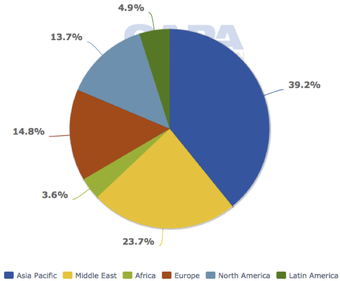 |
This will subsequently be reflected in changing network trends. Air traffic is becoming more diverse geographically, with growth over the next 10 years to be focused on emerging markets. Regionally, approximately half of the world's new traffic added during the next 20 years will be to, from, or within the Asia Pacific region, with the intra-Asia Pacific now the largest aviation market, overtaking the domestic North American market. Over the next 20 years, domestic China will likely overtake the domestic European market, with domestic China passenger traffic forecast to grow from around 320 million passengers in 2012 to 700 million passengers by 2020 and 1.5 billion by 2030.
LCCs will grow faster than average levels, absorbing market share
Meanwhile, low-cost carriers will see proportionally higher growth than the average, meaning that LCCs continue to take market share from other carriers. At the same time, the gap between the short and medium-haul business models of LCCs and traditional network carriers are closing, and LCCs are increasingly tweaking their products and networks to be more business friendly and to capitalise on a reduction in travel budgets that have seen short-haul business travellers in particular becoming more price sensitive.
At the same time, the majority of premium long-haul carriers are investing significantly into developing their long-haul business class products, with a focus on such elements as seat pitch and width, inflight connectivity and WiFi, and an improved on-ground product which also includes mobile apps, social media and intelligent technologies, including geolocation services, to improve the passenger experience.
Market liberalisation is changing the shape of the industry
Another element of the changing competitive landscape is market liberalisation. In this context, airlines have entered an increasing number of joint venture and codeshare agreements and made a flurry of merger and acquisition announcements. Meanwhile, the three main alliances have grown from inception less than 15 years ago to now include over 55 airlines, to cover over 50% of worldwide airline seats and to include all but one of the world's 20 largest carriers.
In the Asia Pacific region, the alliance and hub battle is hotting up. EVA Air and Shenzhen Airlines are scheduled to join Star; Garuda and Xiamen Airlines are joining SkyTeam; and Malaysia Airlines, Kingfisher Airlines and SriLankan Airlines are joining oneworld. As almost all of the world's major airlines have become aligned to a global alliance, alliances are increasingly considering including LCCs as members, with SkyTeam now considering a hybrid partnership platform to target the low-cost and hybrid carriers that largely comprise the unaligned standout carriers.
See related article: SkyTeam plans new partnership platform to attract hybrids and LCCs especially in Brazil and India
The membership platform is targetted largely at carriers in growth markets. SkyTeam hopes to have a platform finalised in early 2013 and to conduct a trial with a hybrid carrier or LCC, although it is not naming potential partners. Depending on the outcome of the trial, SkyTeam would consider expanding the platform.
Much is changing - but the financial returns are generally not.
APPENDIX: IATA 2012 and 2013 forecast
IATA 2009 to 2013F EBIT margin (%) and net profits (USD billion)

IATA 2003 to 2013FY financial and traffic forecasts
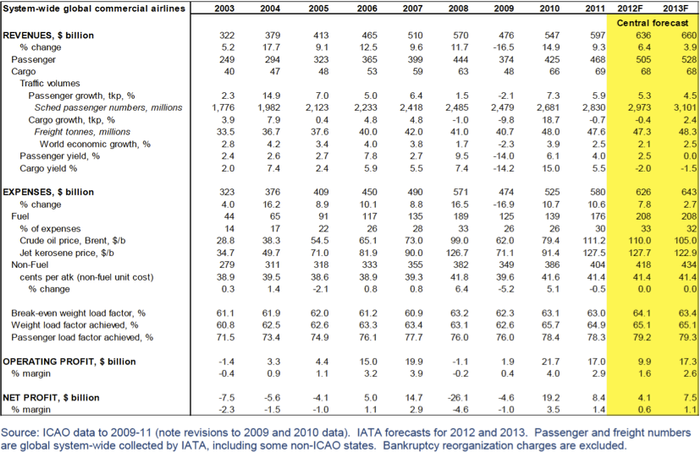
IATA traffic (RTKs) and capacity (ATKs): 2009 to 2013F

